Site menu:

August 2013 Newsletter
Black-tailed Godwits at Caldy.
Wanted - Voluntary Wardens at Point of Ayr.
July Bird News.
Forthcoming Events.
Latest Newsletter.
Black-tailed Godwits at the 'Caldy Wildfowl Collection' April and May 2013
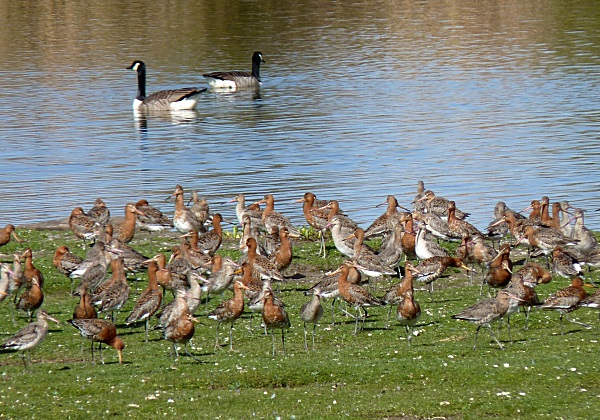
The spring of 2013 was very late as I'm sure
you will all remember. Many of our spring migrants arrived
exceptionally late, but it was strange as everything seemed
mixed
up with some species actually arriving earlier than normal! Our
over-wintering birds, which move further north to breed, were also
effected and we have heard reports of Knot, Redshank and Barnacle Geese
all
being
delayed, and also Black-tailed Godwits.
The normal pattern is for the bulk of the godwits to arrive back in Iceland to breed in the second half of April with the rest ariving in the first week in May. This year the migration was delayed by at least two weeks and we heard of many birds being held up in the Hebrides with 800 on Islay, 1,520 on Tiree and 'thousands' grounded in the Outer Hebrides at the end of April.
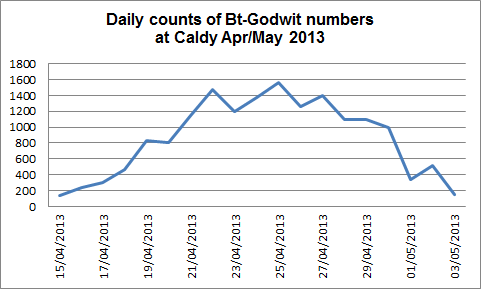
We also had our own delayed
Black-tailed Godwits right here close to the Dee Estuary reaching a
maximum of 1,600
birds in late April, remarkably they were just a short walk from where
I live! They spent most of each day in a field where there is a
collection of wildfowl on the edge of Caldy, usually flying off to the
Dee Estuary
at Thurstaston in the afternoon to feed. With the majority in
full
breeding
plumage it made for a stunning
sight. 20 of the birds were colour-ringed which meant we could find out
their movements before they had reached Caldy and the graph below shows
just how far they range, reaching as far south as Portugal. There is
also much movement of birds between various sites within this
country. 30% we had never seen before in the Dee Estuary area
demonstrating that these weren't just local birds which were delayed
but that they had come from a wide area.
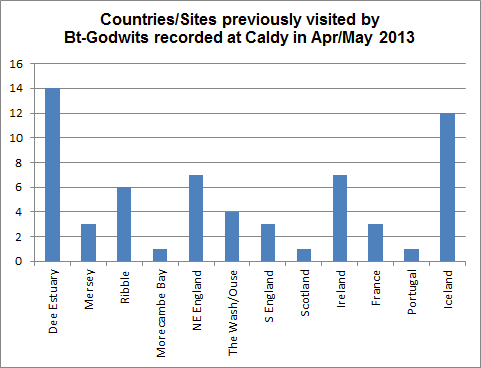
We get so much fascinating detail with these colour ringed birds that it is difficult to summarise in a short article so I thought I'd concentrate on just two birds as good examples of the sort of information we receive.
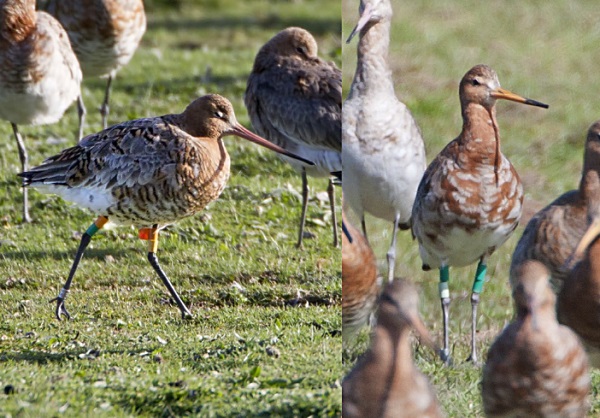
Right - GG-GL photographed by Matt Thomas on May 1st (see fromthemuddybanksofthedee.com).
GG-GL (green over green on left leg, green over light green [also known as lime green] on right leg) was ringed as an adult on spring passage on May 3rd 2000 in Iceland. Outside Iceland it has only been recorded in a fairly narrow strip across the centre of the British Isles.
Iceland
- recorded every May from 2001 to 2009 on spring passage, but
never on it's breeding ground.
Ireland -
recorded both on migration and in the winters of
00/01, 01/02 and 02/03, also on spring migration in 2009.
Humber Estuary
- first seen in August 2003 then every year here during the return
passage up to 2010. It was at nearby Wheldrake Ings in March 2009.
Dee Estuary
- first seen January 2010 then all through the winter of 10/11 at
Thurstaston but not recorded again here until April 2013.
Seaforth Nature Seaforth
- present for two days in March 2012.
The Wash -
only record here was on Sep 21st 2012.
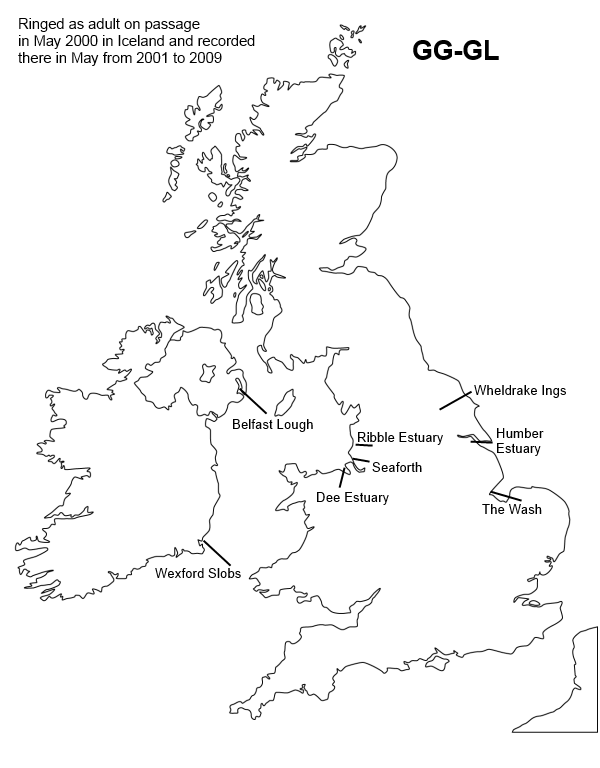
OflagY-OG (Orange flag over yellow on left leg, orange over green on right leg) was ringed on the Moeze Nature Reserve on the Atlantic coast of France on Dec 12th 2007. Since then it has been in France every winter, usually around the Charante Estuary.
On the return passage (Sep/Oct) in 2009 it was on the Wash, and was early returning in 2011 when it was on the Humber Estuary in early July.
It took a trip to Portugal in February 2010 where it was recorded by the Tagus Estuary.
It has never been seen in Iceland and,
before 2013, has never been recorded on spring passage. In 2013 it was
last seen in France on March 7th and turned up at Caldy on April 26th
where it stayed for four days.
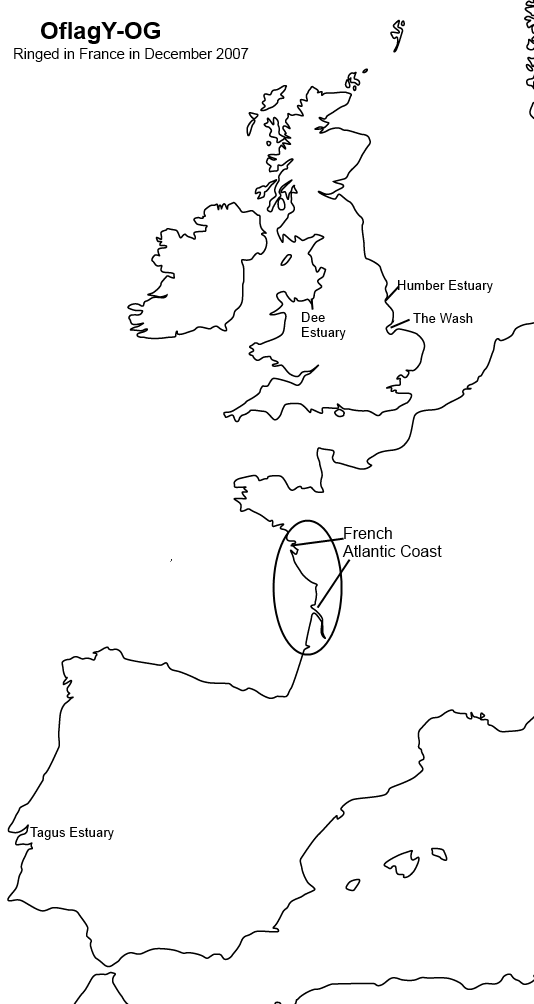
Acknowledgements/Sources of information for this article:
1. "Operation Godwit - Project Jaðrakan", all those 'Blackwit'
enthusiasts who do the ringing and subsequent data compilation, and who
are so prompt at sending out details to people who send their records
in, key people are: Tomas Gunnarsson and Vigfús Eyjólfsson in
Iceland; Jenny Gill, Graham Appleton, Pete Potts and Ruth
Croger in UK; Becca and Jim Wilson in Ireland; Guillaume Gelinaud and
Julien Gonin in France and Jose Alves in Portugal. Also the Farlington
Ringing Group and University of East Anglia play an important part.
As well as being actively involved in ringing many of the above, and
others, have written and/or contributed to various publications
regarding Black-tailed Godwits - see
http://www.uea.ac.uk/~b026515/publications.html.
2. Matt Thomas, 'Following colour ringed migratory shorebirds around Europe - Part 1: Chasing Blackwits', see www.deeestuary.co.uk/news0812.htm.
3. Fellow colour-ring enthusiasts John Jakeman and Matt Thomas who kept me company at Caldy for many hours.
4. foragyll.com for the information regarding birds in the Inner Hebrides.5. Maps kindly provided by University of Texas Libraries (text added by the author).
Richard Smith.
Top of PagePoint of Ayr RSPB Reserve - Voluntary Wardens Wanted!
Point of Ayr, on the North Wales coast at Talacre, is a great place to watch a variety of birds as they come in to roost at high tide, but unfortunately the site is extremely vulnerable to human disturbance. The RSPB is looking for extra volunteers to help warden this invaluable roost site, and protect the birds throughout the cold winter months.
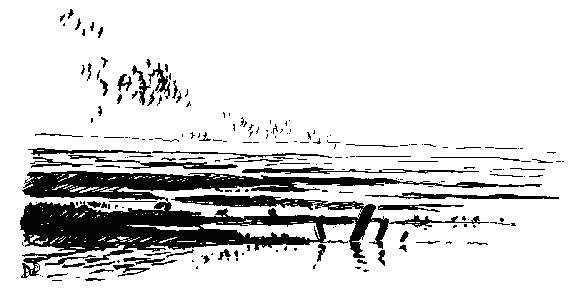
Shifts are run most weekends and typically last between 3-4 hours,
depending on the height of the tide.
If you would like to help in any way please contact the RSPB on 0151
353 8478 or Mobile 07860169452 . Not only
are you helping to save the planet, but it’s also great birdwatching
too!
Editor - to get an idea of how good an area this is for birds see the Point of Ayr Site Guide.
July Bird News
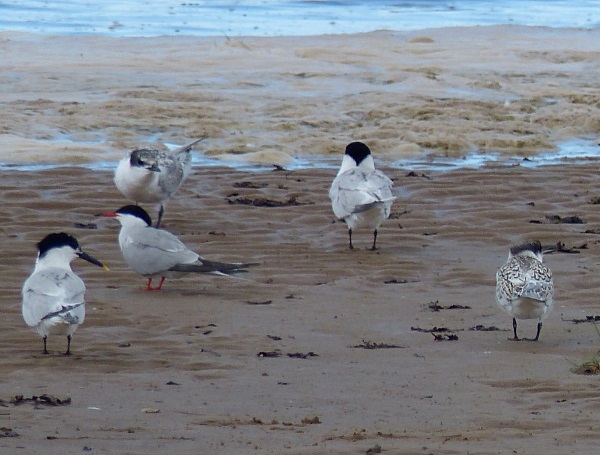
It was fascinating seeing the build up of waders during the month, with most just passing through on passage. The highest count of Greenshanks was at the Connah's Quay Reserve with 18 on the 26th, 15 were at Parkgate on the 20th. Eight Green Sandpipers were at Burton Mere Wetlands on the 26th and eight Spotted Redshanks were seen from the Inner Marsh Farm hide on the 30th, a Wood Sandpiper was also present at the end of the month. A flock of 16 Whimbrels were at Connah's Quay on the 26th. Our more common waders also returned with about 2,500 Redshank and 1,100 Curlew at Heswall by the end of the month.
We also had over-summering non-breeding waders including a flock of over 500 Black-tailed Godwits which were roosting on West Kirby shore early in the month - a rare bird there at any time of year! There was also up to 300 Knot in the area.
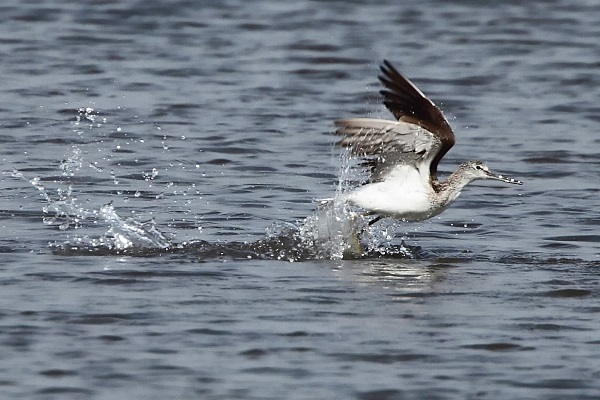
A Pomarine skua off Red Rocks on the 19th was a good record, but there were just a handful of Arctic Skua records. After the gale in mid-June Gannets seemed to disappear from Liverpool Bay for about a month but they returned mid-July with the largest count being of over 80 from Leasowe Lighthouse.
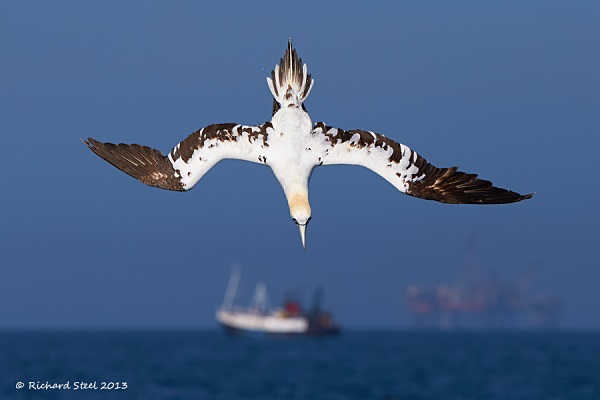
There were no strong westerlies to bring in any Storm Petrels, but two Liverpool Bay pelagic trips during the month produced 10 on the 10th and a single on the 17th. Last month's article on Manx Shearwaters mentioned a Sea Front out in Liverpool Bay, the boats went out to that location and there were certainly plenty of Manx Shearwaters there with 500 counted on the 10th and 200 on the 17th. Also recorded were at least three Great Skuas, a Puffin, a Mediterranean Gull, several Fulmars and many Gannets. Plenty of gulls were attracted to the 'chum' thrown out of the boat, nearly all Lesser Black-backed Gulls.
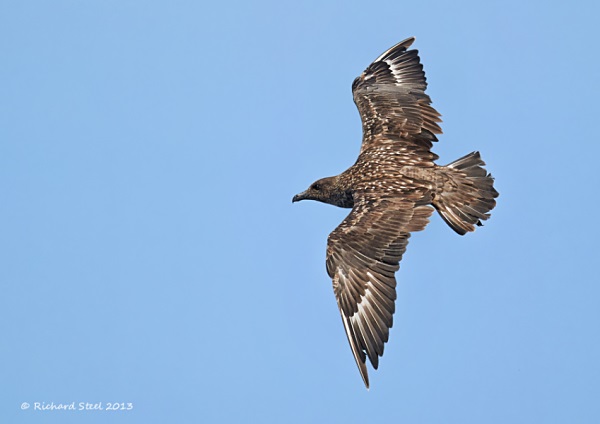
Over 380 Little Egrets came into roost at Burton, a record high number. Based on 2010/11 WeBS data this would make the Dee Estuary the second most important site in the country for this species with only the Wash having a higher count.
Other birds of note recorded this month included a Great White Egret, a female Marsh Harrier, several reports of single Hobbies, a Red Kite, five Crossbills and up to 15 Yellow Wagtails. A Hoopoe was reported flying over Hoylake but never confirmed.
Richard Smith.
What to expect in August
Tern numbers will continue to build and a visit to Hoylake, West Kirby or Point of Ayr at high tide, or Hilbre at low tide, will be a fantastic spectacle with hundreds of both Common and Sandwich Terns, the noise alone is incredible! The Little Terns will have left Gronant and can often be seen feeding in the estuary, a good place is Hilbre gutter on an incoming tide. Some years we can get much rarer Black Terns passing through and an occasional Roseate Tern. These tern hordes will attract skuas, Arctic for certain but also a good chance of Great and Pomarine.
After the quiet of the past few weeks waders will return in their thousands. Dunlin and Ringed Plover will be on the beaches at the mouth of the estuary whereas spectacular numbers of Redshanks, up to 10,000, will be further up the estuary, particularly Heswall. Greenshank, Spotted Redshanks and various sandpipers can be seen at Parkgate, Burton Mere Wetlands and the Connah's Quay Reserve. Harder to spot among all the Dunlin could well be one or two Curlew Sandpipers and Little Stints.
This
time last year we had six Marsh Harriers present on the marshes and
there is also a good chance of an early returning Hen Harrier. August
is also a time when we can see abnormal numbers of Buzzards
congregating when different family parties get together and circle
together, may be as many as 20 or more 'kettling'.
Forthcoming Events
August Highest Spring Tides (Liverpool)
Also
see Tides
page.
21st August, 12.03hrs (BST), 9.5m.
22nd August, 12.46hrs (BST), 9.6m.
23rd August, 13.27hrs (BST), 9.6m.
Forthcoming Events
Organised by the Wirral
Ranger Service , Flintshire Countryside Service and/or the
RSPB:
All these events and walks have bird interest, even those not
advertised specifically for birdwatching. No need to book for these
events unless specified - please check below.
Also see 2013 Events Diary.
Take Tea on Hilbre with the RSPB:
The return of last year’s event by popular demand! Cross the sands to Hilbre Island where the RSPB will be serving tea and cakes during the above times. They will be staffing the bird hide overlooking ‘Niffy Bay’.
To book for this event telephone (0151) 648 4371
Saturday 10th August 10:30am – 5:00pm
The Big Seawatch:
Join the Coastal Rangers, staff from the RSPB, Hilbre Bird Observatory and the Sea Watch Foundation for a day on Hilbre looking for seabirds, wading birds and cetaceans that inhabit our wonderful coast. We will be staying on Hilbre during high tide giving us the best chance to see them with experts on hand! Places are limited with a suggested donation of £5:00 for this event which includes tea/coffee. To book your place please ring (0151) 648 4371
Sunday 11th August, 11:30 start, Terntastic at Point of Ayr.
Price: £3 (suggested donation).
Booking essential
The mouth of the River Dee is a vital feeding ground for terns and
other seabirds before they head off on their long journeys south, and
The Point of Ayr is one of the best places to see them.
On this walk we should see close to 1000 terns (sandwich mainly but
little, common and Arctic terns all occur) roosting close in as the
tide covers up their feeding areas and forces them closer to shore.
Don't forget to bring your binoculars, telescopes and cameras.
So book your place now by phoning 0151 353 8478
Thursday 15th August 11:00am – 3:00pm
Mud Glorious Mud!
Join the Coastal Rangers and RSPB to find out what lives in the sand below our feet on Hoylake beach and learn about the birds that feed on the creatures that we might find! Please be aware that wellingtons are ESSENTIAL for this event and is not suitable for very young children. No need to book - just turn up between the above times. Meet at the Lifeboat Station, King’s Parade, Hoylake.
For further information please ring (0151) 648 4371
Saturday 17th August 12:00noon – 4:00pm
Take Tea on Hilbre with the RSPB:
The return of last year’s event by popular demand! Cross the sands to Hilbre Island where the RSPB will be serving tea and cakes during the above times. They will be staffing the bird hide overlooking ‘Niffy Bay’.
To book for this event telephone (0151) 648 4371
Saturday 24th August 12:00noon start
High Tide Birdwatch at Hoylake:
Join the Coastal Rangers, Dee Estuary Voluntary Wardens and the RSPB on this high tide birdwatch at Hoylake where we will see large numbers of terns as they gather and roost on the shore. We hope to see dunlin, ringed plover etc, as they start to return from their breeding grounds. No need to book. Meet at the bottom of Trinity Road, King’s Parade, Hoylake.
For further information please ring (0151) 648 4371
Saturday 24th August 6:00pm – 9:00pm
Sunset and Wildlife:
Join the Coastal Rangers and RSPB for an evening walk across the sands to Hilbre Island to discover its wildlife and history. Warm waterproof clothing, stout footwear or wellingtons are recommended. Bring binoculars if you have them.
Places are limited and a suggested donation of £3:00 will be gratefully received for this event.
Booking essential (0151) 648 4371
Saturday 7th September 9:30am – 4:30pm
The Big Seawatch
Join the Coastal Rangers, staff from the RSPB and Hilbre Bird Observatory for a day on Hilbre looking for seabirds and wading birds that inhabit our wonderful coast. We will be staying on Hilbre during high tide giving us the best chance to see them with experts on hand! Places are limited with a suggested donation of £5:00 for this event which includes tea/coffee. To book your place please ring (0151) 648 4371
Saturday 14th September 9:00am – 2:00pm
Hilbre Birdwatch:
Join the Coastal Rangers and RSPB on this low water walk across the sands to Hilbre Islands to enjoy the island’s birds and wildlife. Suitable clothing, stout footwear or wellingtons are recommended. Bring binoculars if you have them. Places are limited and a suggested donation of £3:00 will be gratefully received for this event.
Booking is essential (0151) 648 4371